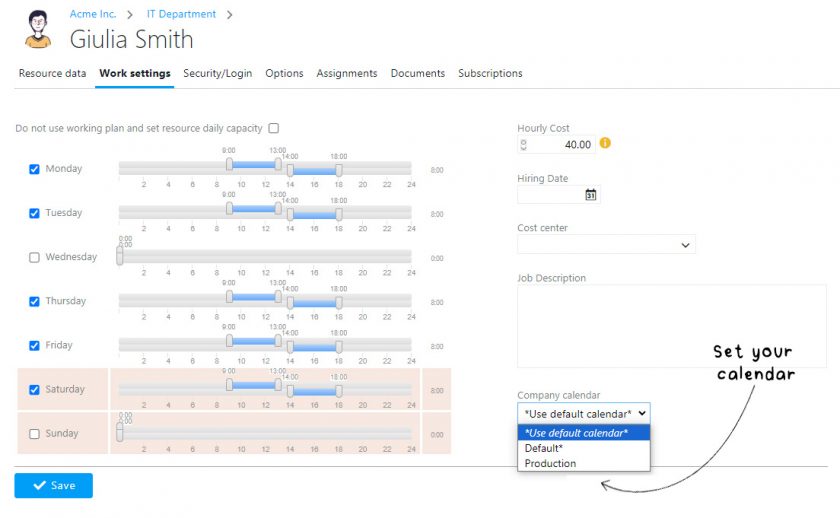Twproject’s calendar has always been efficient and with a highly customisable configuration, but with the recent release it takes a huge step forward by allowing you to define multiple calendars for use on projects and resources.
CONTENT
With this innovation introduced with the release 7.1.018, we want to respond to the need of those who manage different teams and projects with non-uniform working hours.
The coexistence of several calendars is in fact an essential requirement for most structured companies, which necessarily have to manage different work configurations according to departments.
Target audience for the introduction of multiple calendars
With this shared development, Twproject wanted to respond to the most heterogeneous realities. We are talking, for example, about companies with departments that do not share the same working days, or international companies with branches in foreign countries and therefore with a different holiday calendar.
This was therefore an essential innovation to allow flexibility and adherence to the real needs of teams, which nowadays are increasingly manifold.
Until now, the calendar in Twproject allowed the definition of weekly working days and company holidays or closures; this calendar applied to all resources and projects.
It also allowed, from the calendar itself, to set the working hours of resources (such as part-time, etc.).
What changes with the development of multiple calendars
As we have seen, a main, customisable corporate calendar is already present in Twproject, and this is what will now be considered the ‘Default‘ calendar.
The difference will be that from now on for each resource, but also for each project, it will be possible to set a different schedule than the default.
But let’s go into detail: what changes with the introduction of multiple calendars in Twproject and how can we set them up?
Creating and editing a calendar
The system administrator can create a new calendar from the administration page, assigning it a name, description and other data that we will now see.
The calendar editor is in fact divided into two sections: the first contains the name, description, weekly working days and the ‘default’ tick.

It is possible to define only one default calendar.
Please note: the default selection operation must be done with caution as it has an impact on project durations and workloads.
A change in this respect will not directly change the task data, but on first access on the WBS or Gantt the phases will show any inconsistencies due to changes on the calendar.
The second section of the editor relates to the definition of company holidays and closures.
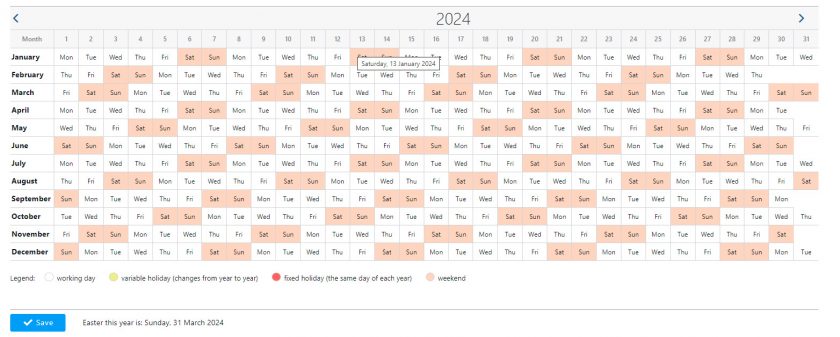
The first click on a cell defines a holiday with a variable date (Easter, Thanksgiving etc.), the second click sets a fixed holiday (Christmas, New Year etc.).
At this point we will have as many calendars as there are different configurations of working days at company level, whether they are determined by different types of work or geographical conditions.
Multiple calendars on resources
But that is not all: there are also important new features in the work settings section of the resource.
For each resource, the calendar to be used can be set via a drop-down menu.
If “Use default calendar” is chosen, the resource in question will use the calendar marked as default (via the tick we saw in the previous section). In this example, the default calendar is called “Default” and has an *.
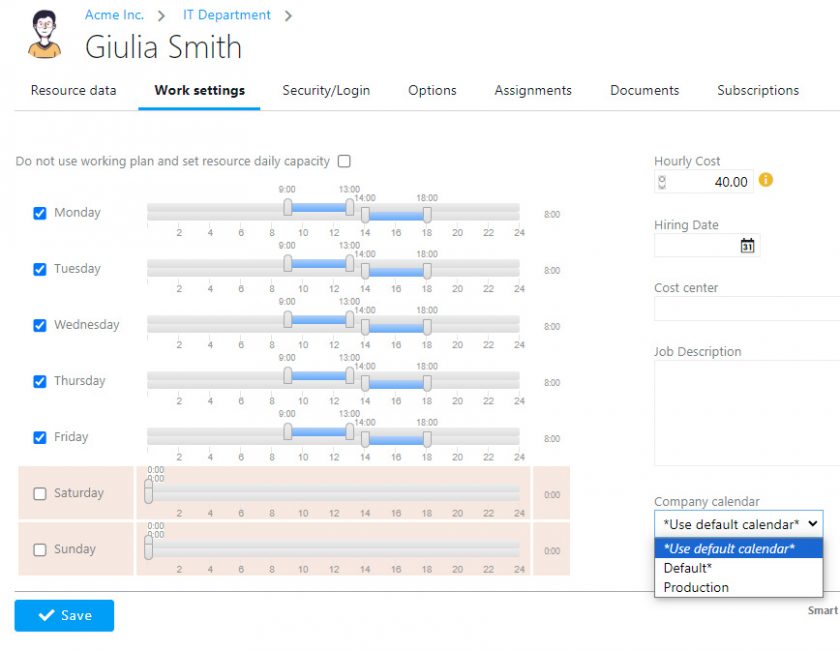
An important new change introduced in this release is that for a resource, working weekdays can be defined, even if they are holidays for the chosen calendar.
This is useful for handling situations where the company generally does not work on Saturdays and Sundays but, for example, the maintenance department does.
Thus, the selected calendar provides public holidays, but working days can be defined for each individual resource.
Similarly to other work data, such as time, cost per hour, etc., the calendar is also inherited from the organisation chart unless otherwise specified.
If the calendar of a department is changed from A to B, all resources of that department that had calendar A will change to B. Those that had calendar C will keep C.
In the example in the image above, we see that the resource ‘Giulia’ uses the default calendar (which has five working days from Monday to Friday), but Giulia, in his specific case, has set Wednesday as non-working and Saturday as working.
Consequently, all interfaces that display the working calendar (such as timesheet, workload, timesheet overview, etc.) will show the non-working days specific to that resource. In the case of Giulia, Wednesday and Sunday.
Multiple calendars on projects
A further step forward is the fact that with the new version it is possible to set a specific timeframe for both the project and the phases.
A new project is always set to the default calendar. In the event of subsequent changes, the name of the chosen calendar will be shown to the right of the dates (as in the image below).
In this way, one could, for example, have a project using the solar calendar (365/365), but operational phases involving specific departments could use a 5/7 calendar.

In the event that the project calendar is changed, e.g. by adding holidays or company closures, so as to interfere with the task dates, a small alert will be displayed the first time we access the project.
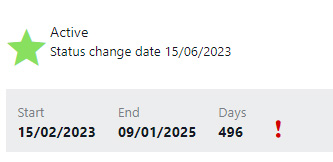
Clicking on the alert will result in a more detailed message, highlighting the points where date changes generated interference.
But how do we change the timing of a project or phase?
To do this, we must use the Gantt diagram; this is because from the Gantt we can immediately see the effects of the change on dates and durations, and there is the possibility of saving at a later date, without the risk of permanently changing the data.
From the options on the project line, we can select the calendar change.
A pop-up will appear for choosing the calendar and deciding whether to try to keep dates or durations.

It is optional to keep dates or durations as far as possible. The conditionality is that there is no guarantee that dates can be kept in full (as in the case where a start or end date corresponds to a holiday for the new calendar).
If milestones or binding dates are violated, the system will send a message and will not carry out the requested change. The user must first change the dates appropriately and then make the change.
With this new version, the first time one logs on to the Gantt, a check will be made to ensure that the start date, end date and duration of the project are consistent with the calendar in use.
In previous versions, if the unique calendar had changed, the end date was simply, and silently, recalculated from the start and duration.
In the new version, dates are kept instead and durations are changed accordingly. In the event of discrepancies, we will see an alert.
If milestones had been touched, these would be highlighted, as well as for the phases that had their duration recalculated.
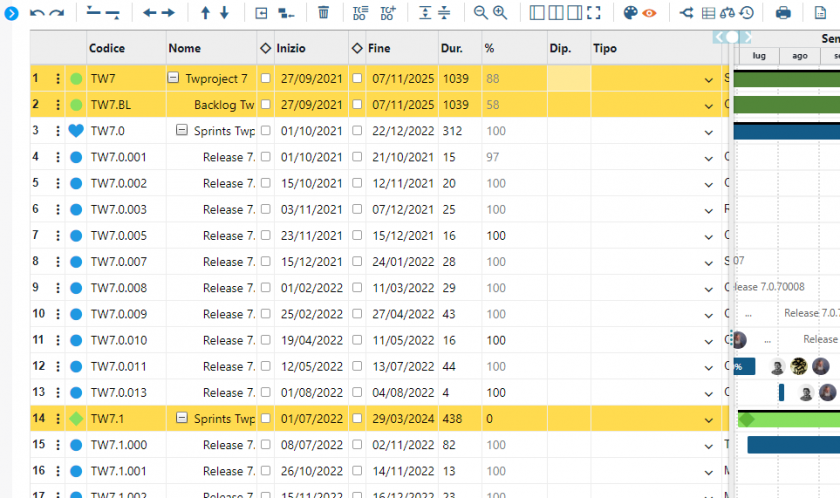
It is sufficient to change even a single piece of data to enable saving and make the new durations definitive.
Effects of multiple calendars on interfaces
Having different calendars on resources and projects also has natural consequences on the appearance of certain Twproject interfaces, such as the Timesheet.
In this case, we note from the bottom line that the employee does not work on Wednesdays and Sundays.
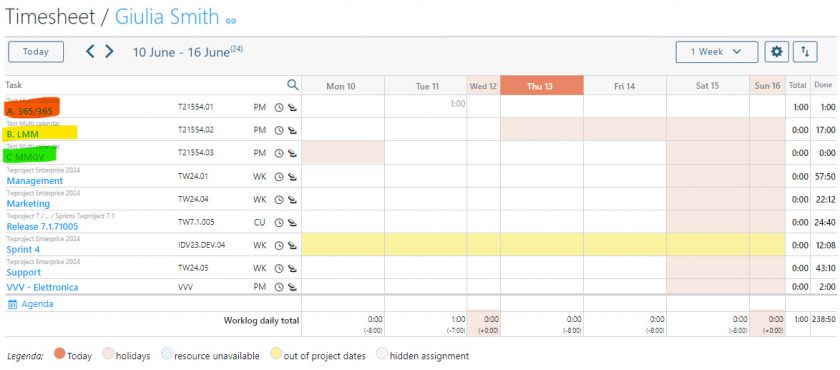
At the same time, however, the projects she works on have different timetables:
- ‘A.365/365‘ (highlighted in red) is always active
- ‘B.LMM‘ (in yellow) is active for the first three days of the week
- ‘C.MMGV‘ (in green) is active from Tuesday to Friday
Users will be able to mark their worklogs freely, while taking into account the information on the timetable of each project, also made clearer by a more comprehensive legenda.
Twproject never inhibits the insertion of worklogs (except in the distant past or in the future), but simply reports the ‘suspicious’ worklog.
For example, if hours worked are recorded on a date that is non-working in both the resource calendar and the project calendar, this will be considered a ‘suspicious’ case, and consequently reported.
In the case of views with several resources, such as the Workload, the different calendars for each resource will be shown:
Or, as in the case of the Timesheet Overview, since this includes an overall group of resources, the company calendar will be shown:

However, indications and reports from the calendar of the resources involved will appear within it.
We have seen how the use of multiple calendars for resources and projects can improve and make scheduling more realistic.
Now you just have to try out this important feature, which helps to make Twproject a tool that is always one step ahead of the others.
Twproject’s multiple calendars allow you to make your time management process much more efficient and to achieve greater flexibility in scheduling resources.
All customers using a Twproject cloud licence have already had the update automatically, while those who have Twproject on server can find the new installers here.
Try this and other features free of charge for 15 days. Start planning and setting work schedules now!

